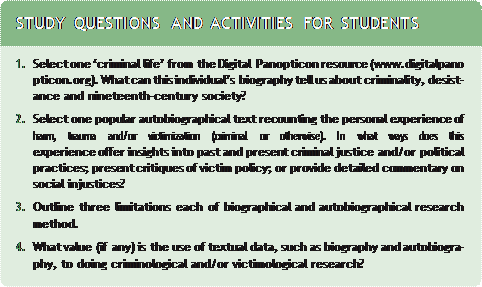 |
Summary and review
|
|
|
|
The aim of this chapter has been to highlight the theoretical and methodological potential of biography and autobiography when studying ‘criminals’ and ‘victims’. We have chosen to present the demonstration of these methods within criminological and victimological research by first placing the uses of biography as a method within criminological research to provide a contextual insight with which to develop our discussion. Next, we outlined the methodological approaches with which to develop sociological and criminological research more broadly, drawing particular attention to the importance of the Chicago School of Sociology and Clifford Shaw’s influential book The Jack Roller. With this scene set, we then sought to illustrate some of the practical and more common uses of biography as a method through exploring how this has been used by criminological historians to reconstruct the lives of criminal ‘others’ for the purposes of critical inquiry. Then, taking the biography of Peter Scannell from the Digital Panopticon project as a working example of a criminological biography, we problematized the use of biography and encouraged critical ways of thinking about this approach when used as a method of social inquiry. Our key obser- vation in this regard is that within criminological research utilizing biography past and present, the ‘victims’ of crime are often conspicuous by their absence. You must also remain conscious of gendered constructions of victimization that should be prob- lematized and challenged by victimological research informed by political influences and cultural practices (qua McGarry and Walklate, 2015). To conclude, we advocate for the continued use and development of biography and autobiography as valuable outlets for critical criminological and victimological inquiry.
 |  | ||

 REFERENCES
REFERENCES
Anderson, N. (1923) The Hobo: The Sociology of the Homeless Man. Chicago: University of Chicago Press.
Barnwell, A. (2017) ‘Life writing and the life course’, Auto/Biography Studies, 32(2): 387–8. Benson, M. L. (2013) Crime and the Life Course: an Introduction. Oxon: Routledge.
Chamberlayne, P. Bornat, J. and Wengraf, T. (2000) ‘Introduction: the biographical turn’, in
P. Chamberlayne, J. Bornat and T. Wengraf (eds), The Turn to Biographical Methods in Social Science: Comparative Issues and Examples. Oxon: Routledge.
Connell, R. (2007) Southern Theory: The Global Dynamics of Knowledge in Social Science. Cambridge: Polity Press.
Crow, I. and Semmens, N. (2008) Researching Criminology. Maidenhead: Open University Press.
Davies, P. (2011) Gender, Crime and Victimisation. London: Sage. Denzin, N. (1989) Interpretive Biography. London: Sage.
Farrington, D. P. and Ttofi, M. M. (2015) ‘Developmental and life-course theories of offend- ing’, in J. Morizot and L. Kasemian (eds), The Development of Criminal and Antisocial Behaviour. Dordrecht: Springer.
|
|
|
Farrington, D. P., Coid, J. W., Harnett, L., Jolliffe, D., Soteriou, N., Turner, R. and West, D. J. (2006) Criminal Careers and Life Success: New Findings from the Cambridge Study in Delinquent Development. London: Home Office (Research Findings No. 281). Available at: www. crim. cam. ac. uk/people/academic_research/david_farrington/hofind281. pdf (accessed May 2018).
Farrington, D. P., Piquero, A. R. and Jennings, W. G. (2013) Offending from Childhood to Late Middle Age: Recent Results from the Cambridge Study in Delinquent Development. New York: Springer.

Foote Whyte, W. (1943) Street Corner Society: The Social Structure of the Italian Slum. Chicago: University of Chicago Press.
Francis, P. (2017) ‘Theoretical perspectives in victimology’, in P. Davies, P. Francis and
C. Greer (eds), Victims, Crime & Society, 2nd edition. London: Sage.
Frost, L. and Maxwell-Stewart, H. (1997) Chain Letters: Narrating Convict Lives. Melbourne: Melbourne University Press.
Gelsthorpe, L. (2007) ‘The Jack-Roller: Telling a story? ’, Theoretical Criminology, 11(4): 515–42. Glueck, S. and Glueck, E. T. (1930) 500 Criminal Careers. New York: Alfred A. Knopf.
Glueck, S. and Glueck, E. T. (1934) One Thousand Juvenile Delinquents. Cambridge, MA: Harvard University Press.
Glueck, S. and Glueck, E. T. (1950) Unravelling Juvenile Delinquency. Cambridge, MA: Harvard University Press.
Glueck, S. and Glueck, E. T. (1968) Delinquents and Non-delinquents in Perspective. Cambridge, MA: Harvard University Press.
Godfrey, B. (2016) ‘Liquid crime history: digital entrepreneurs and the industrial production of “ruined” lives’, in M. H. Jacobsen and S. Walklate (eds), Liquid Criminology: Doing Imaginative Criminological Research. London: Routledge.
Godfrey, B., Alker, Z., Cox, P. and Shore, H. (2017) Young Criminal Lives: Youth Justice and its Impacts, 1855–1925. Oxford: Oxford University Press.
Godfrey, B., Cox, D. and Farrall, S. (2007) Criminal Lives: Family, Employment and Offending. Clarendon Series in Criminology. Oxford: Oxford University Press.
Godfrey, B., Cox, D. and Farrall, S. (2010) Serious Offenders. Clarendon Series in Criminology. Oxford: Oxford University Press.
Goodey, J. (2000) ‘Biographical lessons for criminology’, Theoretical Criminology, 4(4): 473–98. Holloway, W. and Jefferson, T. (2000) ‘Biography, anxiety and the experience of locality’, in
P. Chamberlayne, J. Bornat and T. Wengraf (eds), The Turn to Biographical Methods in Social Science: Comparative Issues and Examples. Oxon: Routledge.
Hudson, B. (2011) ‘Critical reflection as research methodology’, in P. Davies, P. Francis and
V. Jupp (eds), Doing Criminological Research. London: Sage.
Jennings, W. G., Loeber, R., Pardini, D. A., Piquero, A. and Farrington, D. P. (2015) Offending from Childhood to Young Adulthood: Recent Results from the Pittsburgh Youth Study. New York: Springer.
Jewkes, Y. (2011) ‘The media and criminological research’, in P. Davies, P. Francis and
V. Jupp (eds), Doing Criminological Research. London: Sage.
Jupp, V. (1989) Methods of Criminological Research. Oxon: Routledge.
King, R. D. and Wincup, E. (eds) (2008) Doing Crime and Justice Research, 2nd edition. Oxford: Oxford University Press.
Maguire, M. (2008) ‘Researching street criminals in the field’, in R. D. King and E. Wincup (eds), Doing Crime and Justice Research, 2nd edition. Oxford: Oxford University Press. Mawby, R. I. and Walklate, S. (1994) Critical Victimology: International Perspectives.
|
|
|
London: Sage.

McGarry, R. (2016) ‘The “typical victim”: no story to tell, and no one to tell it to’, in
M. H. Jacobsen and S. Walklate (eds), Liquid Criminology: Doing Imaginative Criminological Research. Oxon: Routledge.
McGarry, R. and Walklate, S. (2015) Victims: Trauma, Testimony and Justice. Oxon: Routledge.
McLaughlin, E. and Muncie, J. (2013) (eds) The SAGE Dictionary of Criminology, 3rd edition. London: Sage.
Merton, R. (1988) ‘Some thoughts on the concept of sociological autobiography’, in
M. W. Riley (ed. ) Sociological Lives. Newbury Park, CA: Sage.
Miers, D. (1989) ‘Positivist victimology: a critique, Part 1’, International Review of Victimology, 1(1): 1–29.
Mythen, G. (2007) ‘Cultural victimology: are we all victims now? ’, in S. Walklate (ed. ),
Handbook of Victims and Victimology. Cullompton: Willan Publishing.
Noakes, L. and Wincup, E. (2004) Criminological Research: Understanding Qualitative Methods. London: Sage.
Park, R. E., Burgess, E. W. and McKenzie, R. D. (1925) The City. Chicago: Chicago University Press.
Plummer, K. (1983) Documents of Life: An Introduction to the Problems and Literature of a Humanistic Method. London: George Allen & Unwin.
Plummer, K. (2001) Documents of Life 2: An Invitation to a Critical Humanism. London: Sage.
Rogers, H. (2016) ‘Making their mark: young offenders’ life histories and social networks’, in A. M. Kilday and D. Nash (eds), True Crime Histories: Micro-Studies in Law, Crime and Deviance since 1700. London: Bloomsbury.
Sampson, R. J. and Laub, J. H. (1993) Crime in the Making: Pathways and Turning Points through Life. Cambridge, MA: Harvard University Press.
Sampson, R. J. and Laub, J. H. (1997) ‘A life-course theory of cumulative disadvantage and the stability of delinquency’, in T. Thornberry (ed. ), Developmental Theories of Crime and Deviance: Advances in Criminological Theory, vol. 7. New Brunswick, NJ: Transaction Publishers.
Sampson, R. J. and Laub, J. H. (2003) ‘Life-course desisters? Trajectories of crime among delinquent boys followed to age 70’, Criminology, 41(3): 555–92.
Sampson, R. J. and Laub, J. H. (2006) Shared Beginnings, Divergent Lives: Delinquent Boys to Age 70. Cambridge, MA: Harvard University Press.
Shaw, C. R. (1930) The Jack Roller: A Delinquent Boy’s own Story. Chicago: University of Chicago Press.
Shaw, C. R. and McKay, H. D. (1942) Juvenile Delinquency in Urban Areas: A Study of Rates of Delinquency in Relation to Differential Characteristics of Local Communities in American Cities. Chicago: University of Chicago Press.
Stanley, L. (1992) The Auto/biographical I. Manchester: Manchester University Press. Stanley, L. (1993) ‘On auto/biography in sociology’, Sociology, 27(1): 41–52.
 Sutherland, E. H. (1937) The Professional Thief, by a Professional Thief. Chicago: University of Chicago Press.
Sutherland, E. H. (1937) The Professional Thief, by a Professional Thief. Chicago: University of Chicago Press.
Thomas, W. I. and Znaniecki, F. (1918) The Polish Peasant in America and Europe: Monograph of an Immigrant Group, Volume I – Primary Group Organization. Boston: The Gorham Press.
Thompson, E. P. (1963) The Making of the English Working Class. London: Vintage. Thrasher, F. (1927) The Gang: A Study of 1, 313 Gangs in Chicago. Chicago: University of
Chicago Press.
Turner, J. and Johnston, H. (2016) ‘Female prisoners, aftercare and release: residential provision and support in late nineteenth century England’, British Journal of Community Justice, 13(3): 35–50.
Walby, S., Towers, J. and Francis, B. (2014) ‘Mainstreaming domestic violence into sociol- ogy and the criminology of violence’, The Sociological Review, 62(2): 187–214.
Walklate, S. (1989) Victimology: the Victim and the Criminal Justice Process. London: Unwin Hyman/Oxon: Routledge.
|
|
|
Walklate, S. (2004) Gender, Crime and Criminal Justice. Cullompton: Willan Publishing.
Walklate, S. (2006) ‘Changing the boundaries of the “victim” in restorative justice: so who is the victim now? ’, in D. Sullivan and L. Tifft (eds), Handbook of Restorative Justice: A Global Perspective. Oxon: Routledge.
Walklate, S. (2007) Imagining the Victim of Crime. Maidenhead: Open University Press. Walklate, S., McGarry, R. and Mythen, G. (2014) ‘Trauma, visual victimology, and the poet-
ics of justice’, in M. H. Jacobsen (ed. ), The Poetics of Crime: Excursions into Creative Criminologies. Aldershot: Ashgate.
Wengraf, T., Chamberlayne, P. and Bornat, J. (2002) ‘A biographical turn in the social sci- ences? A British-European view’, Cultural Studies/Critical Methodologies, 2(2): 245–69. Williams, L. (2014) ‘At Large’: Women’s Lives and Offending in Victorian Liverpool and
London. Unpublished PhD thesis, University of Liverpool.
Wincup, E. (2017) Criminological Research: Understanding Qualitative Methods, 2nd edition. London: Sage.
Withrow, B. L. (2014) Research Methods in Crime and Justice. London: Routledge. Young, J. (2011) The Criminological Imagination. Cambridge: Polity Press.
|
|
|


